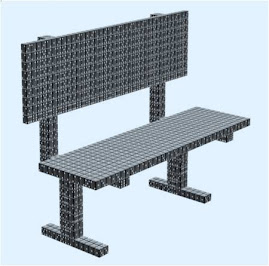
Metamodeling - Wikipedia, the free encyclopedia: "Metamodeling
From Wikipedia, the free encyclopedia
(Redirected from Meta-modeling)
Jump to: navigation, search
Metamodeling, or meta-modeling in software engineering and systems engineering among other disciplines, is the analysis, construction and development of the frames, rules, constraints, models and theories applicable and useful for modeling a predefined class of problems. As its name implies, this concept applies the notions of meta- and modeling.
Example of a eologic map information meta-model, with four types of meta-objects, and their self-references.[1]
Contents
[hide]
* 1 Overview
* 2 Metamodeling topics
o 2.1 Definition
o 2.2 Metadata modeling
o 2.3 Model transformations
o 2.4 Relationship to ontologies
o 2.5 Types of meta-models
o 2.6 Zoos of metamodels
* 3 See also
* 4 References
* 5 Further reading
[edit] Overview
'Metamodeling' is the construction of a collection of 'concepts' (things, terms, etc.) within a certain domain. A model is an abstraction of phenomena in the real world; a metamodel is yet another abstraction, highlighting properties of the model itself. A model conforms to its metamodel in the way that a computer program conforms to the grammar of the programming language in which it is written.
Common uses for metamodels are:
* As a schema for semantic data that needs to be exchanged or stored
* As a language that supports a particular method or process
* As a language to express additional semantics of existing information
Because of the 'meta' character of metamodeling, both the praxis and theory of metamodels are of relevance to metascience, metaphilosophy, metatheories and systemics, and meta-consciousness. The concept can be useful in mathematics, and has practical applications in computer science and computer engineering/software engineering which are main focus of this article.
[edit] Metamodeling topics
[edit] Definition
In software engineering, the use of models is more and more recommended. This should be contrasted with the classical code-based development techniques. A model always conforms to a unique metamodel. One of the currently most active branch of Model Driven Engineering is the approach named model-driven architecture proposed by OMG. This approach is based on the utilization of a language to write metamodels called the Meta Object Facility or MOF. Typical metamodels proposed by OMG are UML, SysML, SPEM or CWM. ISO has also published the standard metamodel ISO/IEC 24744. All the languages presented below could be defined as MOF metamodels.
[edit] Metadata modeling
Metadata modeling is a type of metamodeling used in software engineering and systems engineering for the analysis and construction of models applicable and useful to some predefined class of problems.
[edit] Model transformations
One important move in Model Driven Engineering is the systematic use of Model Transformation Languages. The OMG has proposed a standard for this called QVT for Queries/Views/Transformations. QVT is based on the Meta-Object Facility or MOF. Among many other Model Transformation Languages (MTLs), some examples of implementations of this standard are AndroMDA, VIATRA, Tefkat or MT.
[edit] Relationship to ontologies
Meta-models are closely related to ontologies. Both are often used to describe and analyze the relations between concepts[2]
* Ontologies : express something meaningful within a specified universe or domain of discourse by utilizing a grammar for using vocabulary. The grammar specifies what it means to be a well-formed statement, assertion, query, etc. (formal constraints) on how terms in the ontology’s controlled vocabulary can be used together. [Metamodel-b]
* Meta-modeling : can be considered as an explicit description (constructs and rules) of how a domain-specific model is built. In particular, this comprises a formalized specification of the domain-specific notations. Typically, metamodels are – and always should follow - a strict rule set. [Metamodel-a]. “A valid metamodel is an ontology, but not all ontology are modeled explicitly as metamodels” [Metamodel-b].
[edit] Types of meta-models
For software engineering, several types of models (and their corresponding modeling activities) can be distinguished:
* Metadata modeling (MetaData Model)
* Meta-Process Modeling (MetaProcess Model)
* Executable Meta-Modeling (combining both of the above and much more, as in the general purpose tool Kermeta)
* Model Transformation Language (see below)
[edit] Zoos of metamodels
A library of similar meta-models has been called a Zoo of meta-models.[3] There are several types of meta-model zoos.[4] Some are expressed in ECore. Others are written in MOF 1.4 - XMI 1.2. The metamodels expressed in UML-XMI1.2 may be uploaded in Poseidon for UML, a UML CASE tool.
[edit] See also
Sister project Wikimedia Commons has media related to: Metamodeling
* Data governance
* Model Driven Engineering (MDE)
* Model-driven architecture (MDA)
* Domain Specific Language (DSL)
* Domain-Specific Modeling (DSM)
* Generic Eclipse Modeling System (GEMS)
* Kermeta (Kernel Meta-modeling)
* Meta model (NLP)
* MODAF Meta-Model
* Object Process Methodology
* Requirements analysis
* MOF Queries/Views/Transformations (MOF QVT)
* Surrogate model
* Transformation language
* VIATRA (Viatra)
* XML transformation language (XML TL)
[edit] References
1. ^ David R. Soller et al. (2001) Progress Report on the National Geologic Map Database, Phase 3: An Online Database of Map Information Digital Mapping Techniques '01 -- Workshop Proceedings U.S. Geological Survey Open-File Report 01-223.
2. ^ E. Söderström, et al. (2001) 'Towards a Framework for Comparing Process Modelling Languages', in: Lecture Notes In Computer Science; Vol. 2348. Proceedings of the 14th International Conference on Advanced Information Systems Engineering. Pages: 600 – 611, 2001
3. ^ paper.
4. ^ AtlanticZoo."


Um comentário:
Visit www.theclothing.net to buy Knickers, Aidan Mattox Niteline, Blouses, Persaman, Short Sleeve, Women Clothing, eDM Private Collection, BG Haute, Dave & Johnny, ecoSkin, Computer Bag, Sherri Hill, Tops, Garter, Doori Fashions, Designer Clothes, Dress on sale designed by Veda, Miguel Ases, Jenny Bird, Lucca, Robb and Hugo, sass & bide, Adrienne Landau - always on sale!
Postar um comentário